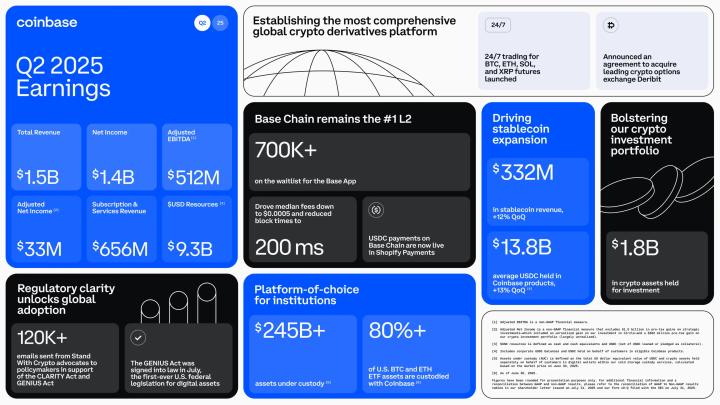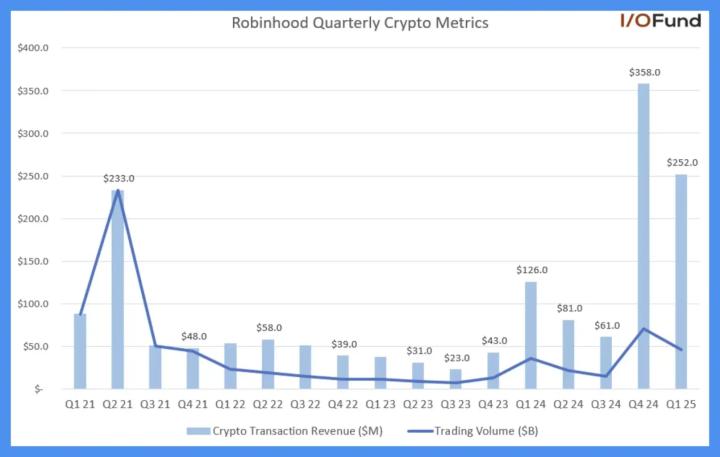As the crypto financial report season arrives, major institutions have submitted their "mid-term report" for 2025. Some achieved profit surge through asset valuation spikes, while others seek transformation paths amid core business slowdown. The industry is gradually shifting from single income dependence to diversified assets and comprehensive financial services. PANews will review the latest financial performance and strategic trends of representative institutions including Strategy, Tether, Coinbase, Robinhood, Kraken, and Riot Platforms that are publicly listed crypto concept companies or have actively disclosed their second-quarter financial reports.
[Rest of the translation continues in the same manner, maintaining the specified translations for specific terms]Tether: Quarterly Net Profit of $4.9 Billion, U.S. Treasury Holdings Exceed $127 Billion
As of Q2 2025, Tether's total assets reached $162.575 billion, exceeding its $157.108 billion in liabilities, achieving an excess reserve of $5.467 billion (slightly down from $5.6 billion in the previous quarter); USDT circulation exceeded $157 billion, increasing by $20 billion year-to-date.
In terms of asset composition, U.S. Treasury holdings exceeded $127 billion (including $105.5 billion in direct holdings and $21.3 billion in indirect holdings), increasing by about $8 billion from the first quarter, ranking as one of the top 18 global U.S. Treasury holders, and also holding $8.9 billion worth of Bitcoin and $8.7 billion worth of precious metals (gold).
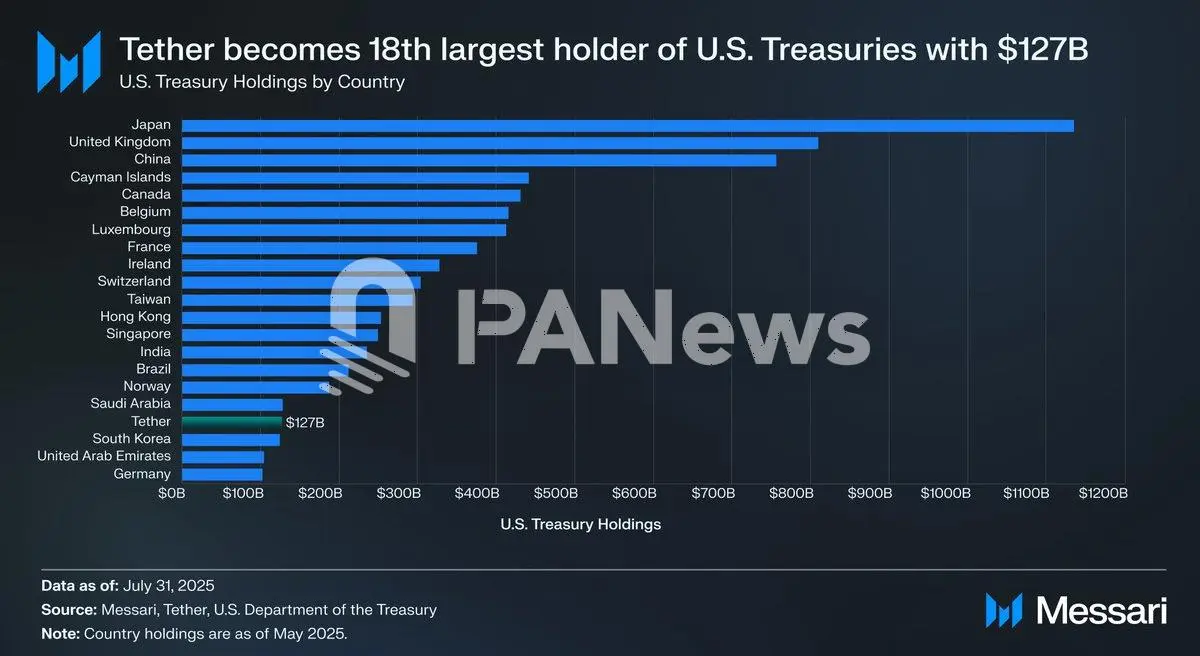
Tether's net profit in the second quarter was approximately $4.9 billion, significantly higher than $830 million in the first quarter. Year-to-date, Tether has accumulated a net profit of $5.73 billion, of which $3.1 billion is recurring income and $2.6 billion comes from market value growth of Bitcoin and gold.
Overall, Tether demonstrated strong asset growth capabilities and profitability this quarter, with its diversified asset allocation (such as gold and Bitcoin) providing flexibility to its profit structure.
Robinhood: Revenue Nears $1 Billion, Crypto Business Doubles Profit
As of the end of Q2 2025, Robinhood's balance sheet held $4.2 billion in cash and cash equivalents, providing ample "ammunition" for global expansion and new business trials.

This quarter, Robinhood achieved revenue of $989 million, a 45% year-on-year increase; net profit reached $386 million, doubling year-on-year, hitting a historical high. Adjusted EBITDA was $549 million, with profit margin rising to 56%. The core engine driving this growth was the strong rebound in crypto trading and options trading. Options trading revenue reached $265 million, a 46% year-on-year increase, remains the core income source; crypto trading revenue reached $160 million, a 98% year-on-year increase, becoming a new growth driver; stock trading revenue also recorded $66 million, a 65% year-on-year increase.
Robinhood maintained strong performance in user scale and asset accumulation. The platform currently has 26.5 million funded accounts, a 10% year-on-year increase; total platform assets exceeded $279 billion, nearly doubling; active investment accounts reached 27.4 million, a 10% year-on-year increase; high-value users (Robinhood Gold subscribers) grew 76% to 3.5 million. Notably, average revenue per user (ARPU) reached $151, a 34% year-on-year increase, reflecting the platform's continuously improving user monetization capability.
Strategically, the most noteworthy aspect is Robinhood's bold layout in crypto business this quarter, including officially completing the acquisition of European veteran exchange Bitstamp; obtaining over 50 crypto compliance licenses and launching crypto services in 30 European countries; introducing stock token products; opening crypto staking functionality in the U.S., and planning to complete the acquisition of Canadian WonderFi in the second half of the year. Additionally, Robinhood is gradually building its financial supermarket, such as Robinhood Strategies digital advisory service AUM reaching $500 million, retirement account assets at $20 billion, and Gold credit card users reaching 300,000.
Kraken: Profit Halved, Plans to Accelerate Diversification
In Q2 2025, Kraken continued to advance in multi-asset trading and global expansion, but overall market trading activity slightly slowed, leading to a quarter-on-quarter decline in some key indicators.
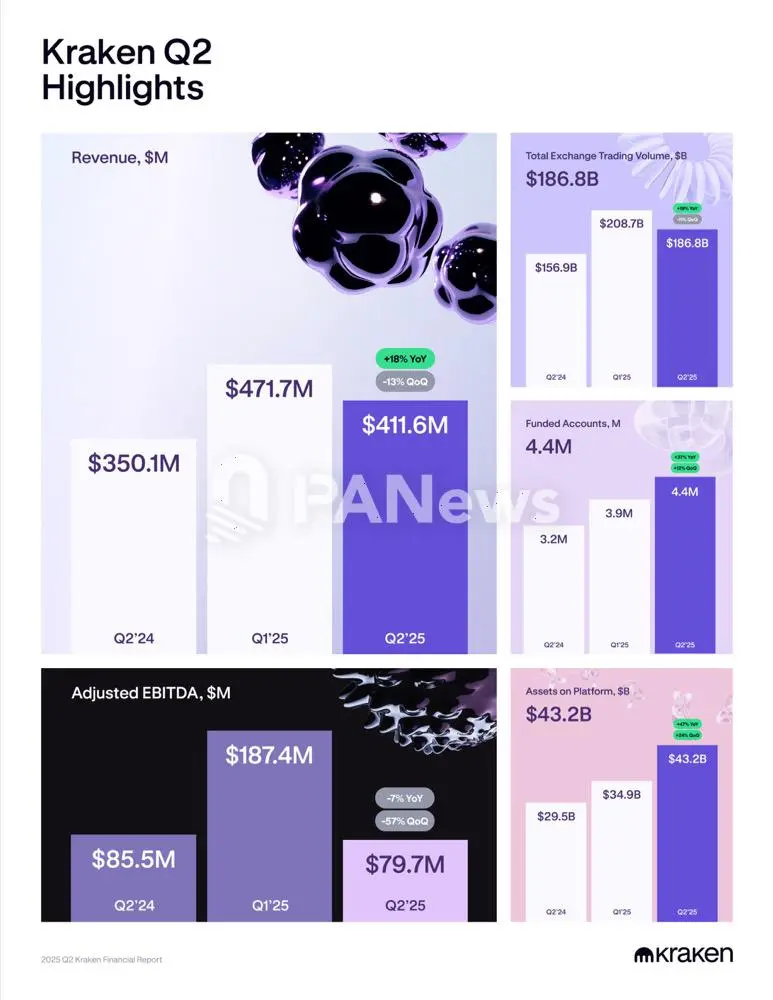
This quarter, Kraken achieved revenue of $412 million, a 18% year-on-year increase, but a quarter-on-quarter decrease from $472 million. Adjusted EBITDA was $80 million, showing a significant drop from Q1's $187 million. In operational data, Kraken has about 15 million global customers, with total trading volume of $186.8 billion in Q2, a 10.5% quarter-on-quarter decrease but still a 19% year-on-year increase; Kraken's funded accounts increased to 4.4 million, with a remarkable 37% year-on-year growth; platform custody assets reached $43.2 billion, an impressive 47% year-on-year increase.
Moving forward, Kraken's global business will continue to accelerate, including new license approvals, local fund channel expansion, multi-asset experience upgrades, and innovative product launches, such as international stocks, tokenized stocks, Kraken debit financial card, and NinjaTrader development.
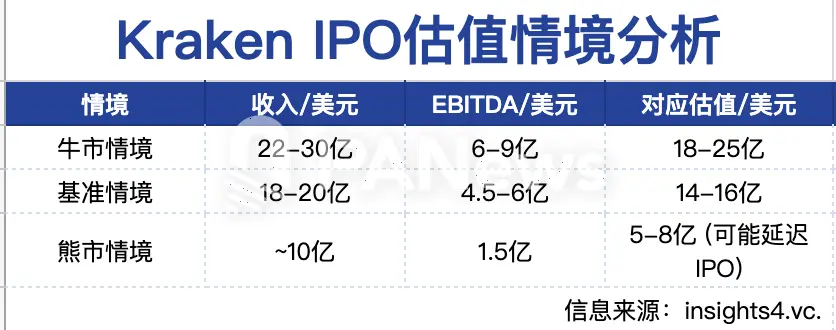
Notably, Kraken is seeking to raise $500 million at a $15 billion valuation and plans to go public in 2026. Insights4.vc analysis suggests that Kraken, with top-tier user quality and trading activity, is continuously reducing its dependence on spot trading fees by expanding derivatives, stock trading, and payment services, enhancing its risk resistance to market cycles. Moreover, in the context of stricter regulation, Kraken has obtained compliance licenses in multiple regions, with significant advantages in compliance, safety, and fiat entry services. Facing fierce competition from Binance and Coinbase, Kraken has successfully established a "second-tier" brand positioning focused on product diversity and transparent compliance. If the crypto market continues to recover in the next year, Kraken may become another profitable and compliant crypto exchange to go public after Coinbase.
Riot Platforms: Revenue Doubles, BTC Production Increases 69%
In Q2 2025, Riot Platforms achieved total revenue of $153 million, more than doubling from $70 million in the same period of 2024, with growth primarily driven by Bitcoin mining, contributing about $141 million in revenue, an increase of over 150%. Driven by strong Bitcoin prices and capacity expansion, the company produced 1,426 BTC during the quarter, an approximately 69% increase from 844 BTC in the same period last year.
Affected by the 2024 April halving event and continuous global computing power increase, Riot's average Bitcoin mining cost (excluding depreciation) rose to $48,992, a 93% year-on-year increase, but still significantly lower than the average Bitcoin selling price of around $98,800. However, if Bitcoin prices fall or mining difficulty continues to rise, profit margins may be squeezed, with cost control and computing power efficiency becoming critical. According to Riot's disclosure, with the rising demand for high-performance computing (HPC) and AI infrastructure, the company will continue to promote diversified application of electrical resources, gradually transforming from a single Bitcoin mining company to an "infrastructure platform centered on Bitcoin and facing future computing power needs".
In terms of profit performance, Riot recorded a net profit of $219.5 million, far exceeding the negative performance in the same period of 2024, with an adjusted EBITDA of $495.3 million, reflecting its strong cash generation capacity and high operating leverage.
Additionally, the company continues to maintain a robust balance sheet. As of the end of the second quarter, Riot Platforms held a total of 19,273 BTC (valued at approximately $2.1 billion), as well as $255.4 million in unrestricted cash, which provides ample funding for its future expansion, high-performance computing transformation, or addressing market fluctuations.




